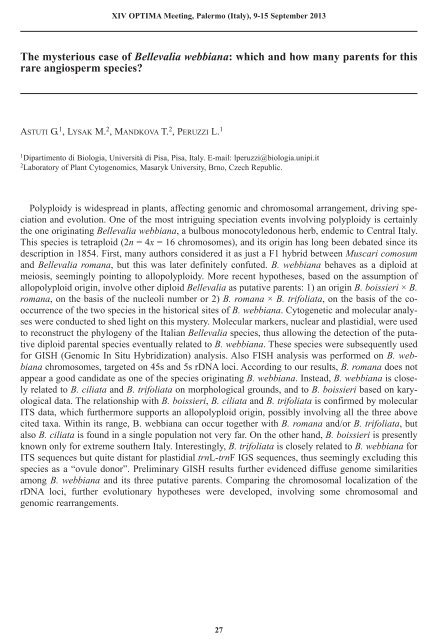Abstracts, XIV OPTIMA Meeting, Palermo (Italy) , 9-15
Abstracts, XIV OPTIMA Meeting, Palermo (Italy) , 9-15
Abstracts, XIV OPTIMA Meeting, Palermo (Italy) , 9-15
You also want an ePaper? Increase the reach of your titles
YUMPU automatically turns print PDFs into web optimized ePapers that Google loves.
<strong>XIV</strong> <strong>OPTIMA</strong> <strong>Meeting</strong>, <strong>Palermo</strong> (<strong>Italy</strong>), 9-<strong>15</strong> September 2013<br />
The mysterious case of Bellevalia webbiana: which and how many parents for this<br />
rare angiosperm species?<br />
ASTUTI G. 1 , LYSAK M. 2 , MANDKOVA T. 2 , PERUZZI L. 1<br />
1 Dipartimento di Biologia, Università di Pisa, Pisa, <strong>Italy</strong>. E-mail: lperuzzi@biologia.unipi.it<br />
2 Laboratory of Plant Cytogenomics, Masaryk University, Brno, Czech Republic.<br />
Polyploidy is widespread in plants, affecting genomic and chromosomal arrangement, driving speciation<br />
and evolution. One of the most intriguing speciation events involving polyploidy is certainly<br />
the one originating Bellevalia webbiana, a bulbous monocotyledonous herb, endemic to Central <strong>Italy</strong>.<br />
This species is tetraploid (2n = 4x = 16 chromosomes), and its origin has long been debated since its<br />
description in 1854. First, many authors considered it as just a F1 hybrid between Muscari comosum<br />
and Bellevalia romana, but this was later definitely confuted. B. webbiana behaves as a diploid at<br />
meiosis, seemingly pointing to allopolyploidy. More recent hypotheses, based on the assumption of<br />
allopolyploid origin, involve other diploid Bellevalia as putative parents: 1) an origin B. boissieri × B.<br />
romana, on the basis of the nucleoli number or 2) B. romana × B. trifoliata, on the basis of the cooccurrence<br />
of the two species in the historical sites of B. webbiana. Cytogenetic and molecular analyses<br />
were conducted to shed light on this mystery. Molecular markers, nuclear and plastidial, were used<br />
to reconstruct the phylogeny of the Italian Bellevalia species, thus allowing the detection of the putative<br />
diploid parental species eventually related to B. webbiana. These species were subsequently used<br />
for GISH (Genomic In Situ Hybridization) analysis. Also FISH analysis was performed on B. webbiana<br />
chromosomes, targeted on 45s and 5s rDNA loci. According to our results, B. romana does not<br />
appear a good candidate as one of the species originating B. webbiana. Instead, B. webbiana is closely<br />
related to B. ciliata and B. trifoliata on morphological grounds, and to B. boissieri based on karyological<br />
data. The relationship with B. boissieri, B. ciliata and B. trifoliata is confirmed by molecular<br />
ITS data, which furthermore supports an allopolyploid origin, possibly involving all the three above<br />
cited taxa. Within its range, B. webbiana can occur together with B. romana and/or B. trifoliata, but<br />
also B. ciliata is found in a single population not very far. On the other hand, B. boissieri is presently<br />
known only for extreme southern <strong>Italy</strong>. Interestingly, B. trifoliata is closely related to B. webbiana for<br />
ITS sequences but quite distant for plastidial trnL-trnF IGS sequences, thus seemingly excluding this<br />
species as a “ovule donor”. Preliminary GISH results further evidenced diffuse genome similarities<br />
among B. webbiana and its three putative parents. Comparing the chromosomal localization of the<br />
rDNA loci, further evolutionary hypotheses were developed, involving some chromosomal and<br />
genomic rearrangements.<br />
27






